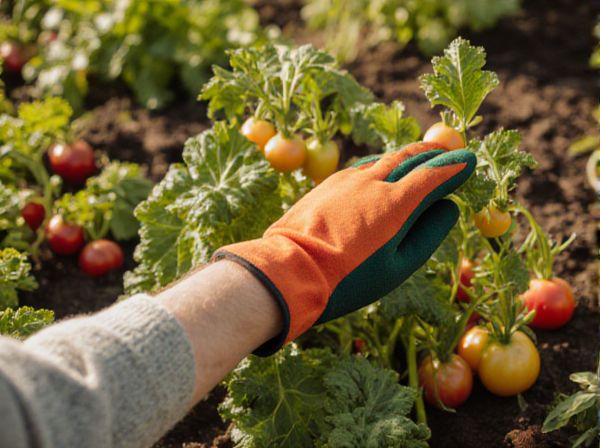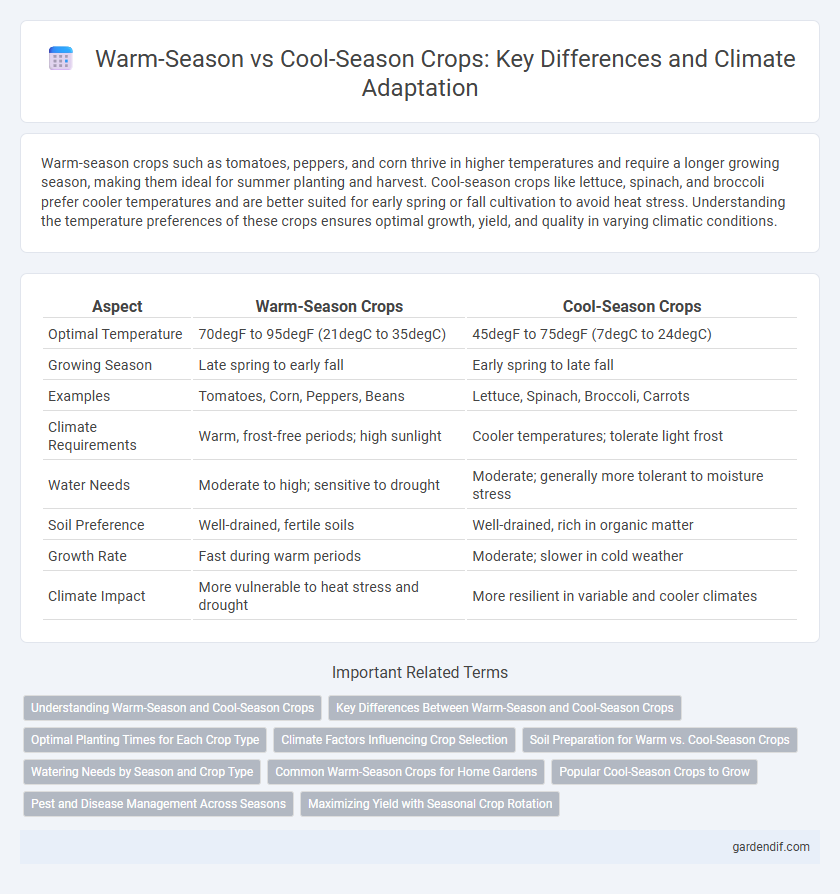
Warm-season crops vs cool-season crops Illustration
Warm-season crops such as tomatoes, peppers, and corn thrive in higher temperatures and require a longer growing season, making them ideal for summer planting and harvest. Cool-season crops like lettuce, spinach, and broccoli prefer cooler temperatures and are better suited for early spring or fall cultivation to avoid heat stress. Understanding the temperature preferences of these crops ensures optimal growth, yield, and quality in varying climatic conditions.
Table of Comparison
| Aspect | Warm-Season Crops | Cool-Season Crops |
|---|---|---|
| Optimal Temperature | 70degF to 95degF (21degC to 35degC) | 45degF to 75degF (7degC to 24degC) |
| Growing Season | Late spring to early fall | Early spring to late fall |
| Examples | Tomatoes, Corn, Peppers, Beans | Lettuce, Spinach, Broccoli, Carrots |
| Climate Requirements | Warm, frost-free periods; high sunlight | Cooler temperatures; tolerate light frost |
| Water Needs | Moderate to high; sensitive to drought | Moderate; generally more tolerant to moisture stress |
| Soil Preference | Well-drained, fertile soils | Well-drained, rich in organic matter |
| Growth Rate | Fast during warm periods | Moderate; slower in cold weather |
| Climate Impact | More vulnerable to heat stress and drought | More resilient in variable and cooler climates |
Understanding Warm-Season and Cool-Season Crops
Warm-season crops such as tomatoes, peppers, and corn thrive in temperatures between 70degF and 85degF, requiring longer daylight and warmer soil conditions for optimal growth. Cool-season crops like lettuce, spinach, and broccoli are adapted to temperatures between 45degF and 65degF, performing best in early spring or fall when the climate is cooler and frost risk is low. Understanding the specific temperature and daylight requirements of each crop category is essential for maximizing yield and ensuring healthy plant development in varying climates.
Key Differences Between Warm-Season and Cool-Season Crops
Warm-season crops, such as tomatoes and corn, thrive in temperatures between 70degF and 85degF, requiring longer daylight hours for optimal growth, while cool-season crops like lettuce and spinach prefer temperatures ranging from 45degF to 65degF and can tolerate light frosts. Warm-season crops typically have higher heat and sunlight requirements, leading to a growing season concentrated in late spring through summer. In contrast, cool-season crops are adapted to shorter daylight periods and cooler climates, allowing them to be planted early in spring or late in fall, maximizing productivity in temperate regions.
Optimal Planting Times for Each Crop Type
Warm-season crops like tomatoes, peppers, and corn thrive when planted after the last frost date, typically late spring to early summer, ensuring soil temperatures consistently exceed 60degF (15degC). Cool-season crops such as lettuce, spinach, and broccoli benefit from early spring or late summer planting, favoring cooler soil temperatures between 45degF and 65degF (7degC to 18degC) to avoid heat stress. Timing planting to match these temperature thresholds maximizes germination rates and crop yields while minimizing risks of frost damage or heat-related growth issues.
Climate Factors Influencing Crop Selection
Climate factors such as temperature, precipitation, and frost risk significantly influence the selection of warm-season and cool-season crops. Warm-season crops like corn and tomatoes thrive in higher temperatures and longer growing seasons, requiring consistent warmth above 60degF (15degC). Cool-season crops such as lettuce and broccoli favor milder temperatures between 40degF and 75degF (4degC to 24degC) and can tolerate light frosts, making them suitable for regions with shorter, cooler growing periods.
Soil Preparation for Warm vs. Cool-Season Crops
Soil preparation for warm-season crops requires well-drained, nutrient-rich soil with a pH between 6.0 and 7.0 to support rapid root development and heat tolerance. In contrast, cool-season crops thrive in soils with slightly higher moisture retention and a pH closer to 6.5, benefiting from early tillage and organic matter incorporation to enhance fertility and structure. Proper soil temperature management before planting ensures optimal seed germination and crop establishment in both warm and cool-season cultivation.
Watering Needs by Season and Crop Type
Warm-season crops such as tomatoes, peppers, and cucumbers require consistent, deep watering during hot, dry periods to prevent stress and optimize fruit development, typically needing about 1-2 inches of water per week. Cool-season crops like lettuce, spinach, and broccoli benefit from frequent, shallow watering to maintain moisture in cooler soil temperatures, reducing the risk of bolting and ensuring tender growth. Adjusting watering schedules based on crop type and seasonal temperature variations maximizes water efficiency and promotes healthy crop yields.
Common Warm-Season Crops for Home Gardens
Tomatoes, peppers, and cucumbers are common warm-season crops thriving in the higher temperatures and longer daylight of summer months. These crops require soil temperatures consistently above 60degF for optimal germination and growth, making them ideal for planting after the last frost date. Warm-season crops also benefit from full sun exposure and well-drained soil rich in organic matter to maximize yield in home gardens.
Popular Cool-Season Crops to Grow
Popular cool-season crops include kale, broccoli, spinach, and carrots, thriving in temperatures between 45degF and 75degF. These crops are planted in early spring or late summer to avoid the heat stress of peak summer, ensuring optimal growth and yield. Their ability to tolerate frost and cooler soil conditions makes them essential for extending the growing season in temperate climates.
Pest and Disease Management Across Seasons
Warm-season crops typically face higher risks of pest infestations such as aphids and whiteflies due to elevated temperatures that accelerate insect life cycles and disease proliferation. Cool-season crops often encounter fungal diseases like powdery mildew and downy mildew, favored by cooler, moist conditions that inhibit pest mobility but promote pathogen growth. Effective pest and disease management strategies must therefore be seasonally tailored, incorporating crop rotation, resistant varieties, and targeted chemical or biological controls specific to the climatic conditions affecting pest and pathogen dynamics.
Maximizing Yield with Seasonal Crop Rotation
Maximizing yield through seasonal crop rotation involves strategically alternating warm-season crops like tomatoes and peppers with cool-season crops such as lettuce and broccoli to optimize soil nutrients and reduce pest pressure. Warm-season crops thrive in temperatures above 70degF, while cool-season crops prefer cooler conditions between 45degF and 65degF, allowing farmers to extend harvesting periods and improve overall productivity. Implementing this rotation enhances soil fertility, minimizes disease buildup, and supports sustainable agricultural practices under varying climate conditions.
Warm-season crops vs cool-season crops Infographic

 gardendif.com
gardendif.com